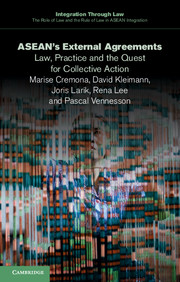Book contents
- Frontmatter
- Contents
- List of tables
- List of charts
- General editors' preface
- 1 Introduction
- 2 The legal and institutional framework for ASEAN external agreements: the centrality of ASEAN
- 3 An inventory and typology of ASEAN external instruments: overview and trends
- 4 ASEAN as a contracting party
- 5 Beyond market access? The anatomy of ASEAN's preferential trade agreements
- 6 A regional strategy: a typology of ASEAN partnership and co-operation agreements
- 7 Between great-power rivalries and supranationality: ASEAN external instruments and regional hedging strategies
- Executive summary
- Appendices
- Index
4 - ASEAN as a contracting party
Published online by Cambridge University Press: 05 May 2015
- Frontmatter
- Contents
- List of tables
- List of charts
- General editors' preface
- 1 Introduction
- 2 The legal and institutional framework for ASEAN external agreements: the centrality of ASEAN
- 3 An inventory and typology of ASEAN external instruments: overview and trends
- 4 ASEAN as a contracting party
- 5 Beyond market access? The anatomy of ASEAN's preferential trade agreements
- 6 A regional strategy: a typology of ASEAN partnership and co-operation agreements
- 7 Between great-power rivalries and supranationality: ASEAN external instruments and regional hedging strategies
- Executive summary
- Appendices
- Index
Summary
Introduction
This chapter addresses a question of fundamental importance to ASEAN external relations: which entities are the parties to the agreements and other instruments concluded or issued in the name of ASEAN? As practice to date shows, there is by no means one straightforward answer to this. According to its Charter, ASEAN has been accorded legal personality (Article 3) as well as an explicit international treaty-making power (Article 41(7)). However, the procedures for exercising the latter, for the elaboration of which the Charter mandates ‘the ASEAN Coordinating Council in consultation with the ASEAN Community Councils’ (Article 41(7)), remained wanting until recently (Chapter 2 above). Nonetheless, there are instances in which ASEAN, on its own behalf as an international organisation, has concluded international agreements even before the Charter entered into force. Furthermore, it was pointed out that the Charter exhibits rather grand ambitions for ASEAN in its relations with the region and the world at large (see Chapter 2 above). But as this chapter shows, this means in no way that ASEAN, as an international legal person, acts as the protagonist in the expanding practice of external relations. There is little apparent consistency in how ASEAN presents itself to its partners (Appendix 3 below).
Hence, in order to better understand ASEAN as an international actor, deeper scrutiny of this issue becomes imperative with a view to revealing certain patterns of action by ASEAN and its members, but also to highlighting certain characteristics of its external action, i.e. recurring cases of confusion as to which entity its external partners are actually dealing with. This chapter will elaborate on this in the following order: to start, the existing practice is systematised into different modes which ASEAN employs to conclude international instruments with its partners, which distinguish between the use of ASEAN as a collective label by its member states and the acts of ASEAN as an international legal person.
- Type
- Chapter
- Information
- ASEAN's External AgreementsLaw, Practice and the Quest for Collective Action, pp. 84 - 133Publisher: Cambridge University PressPrint publication year: 2015

